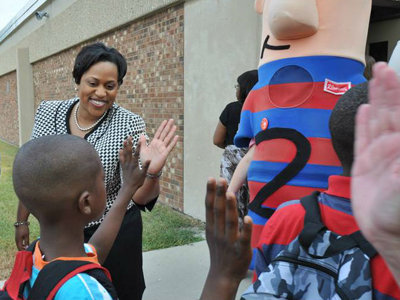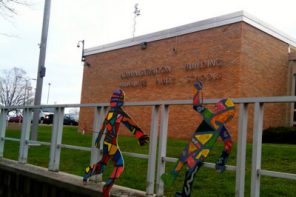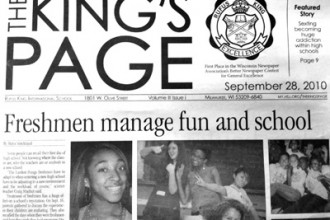I just turned 40 a few weeks ago — barely into my prime! — but it seems I have reached the point in my life/teaching career where both my principal and superintendent are younger than I am. The times they are … etc.
This bit of self-reflection is prompted, of course, by the somewhat-surprising vote by the Milwaukee Board of School Directors to promote Dr. Darienne Driver from acting to actual superintendent of the state’s largest public school district.
Dr. Driver assumes the post at a time of incredible transition in the state and the district, beyond just what a change of leadership might mean. There’s the “perfect storm,” as I’ve been calling it, that has left a lot of teachers feeling like they’re drowning here at the start of school. Yet Driver told OnMilwaukee.com that “now, a month in, we’re smooth sailing,” and if I were a coffee drinker I would have choked on it because that’s just not what I’m seeing here on the ground, to slightly mix metaphors. (editor’s note: Driver said the district was “smooth sailing” in reference to the implementation of a new dashboard, not overall)
Competition from other sectors — voucher and charter schools — seems stronger now than in recent years, in part because there’s a sense, not always supported by the data, that the quality in those sectors has improved recently. There’s also a big change coming in how students are assessed — testing starts this week already! — and whatever disappointing or alarming results those tests will undoubtedly produce.
And there is the very real threat that an unfriendly state government will start dismantling the district starting next spring — election results depending. Driver’s optimism about the things that are is not completely unwarranted, but it is belied somewhat by a potentially hostile educational landscape in Milwaukee. The smooth sailing might not last long.
But I also want to take a moment and catalog some things about the Milwaukee Public Schools that are not changing. Things that should probably change, but that are far beyond the control of me or Dr. Driver or any one other person. Things that are, in fact, completely outside of the educational system, yet things that, when considered collectively, explain quite a bit about the state of education in Milwaukee’s schools.
For example, Milwaukee remains the most segregated large metropolitan region by race and class in the country. Segregation is not exclusively or even especially a Milwaukee problem, of course — it’s a wholly American one. But it is a problem that comes with many corollaries, including effects on its public school systems. Poor students are concentrated in MPS with other poor students; it is hard to find anything resembling a racially “integrated” school in MPS anymore.
Studies show that both of these, concentrations of poverty and a lack of integration, contribute strongly to lower student achievement. Americans have known this for generations, and that we have let it get worse since the end of the Civil Rights era is an embarrassment and a national shame.
No doubt the segregation contributes to the sense of growing unrest among Milwaukee’s non-white communities. Over the last several months, for example, residents have staged a series of escalating protests over the death of Dontre Hamilton, shot by a police officer in Red Arrow Park earlier this year. Hamilton’s death followed closely upon the decision not to prosecute officers for the death of another African American man in their custody, Derek Williams — also loudly protested by residents.
Dr. Driver’s attitude is positive and optimistic, and the protests are neither her fault nor directed at her. But she takes the reins of this city’s schools at a time when tension here is mounting in a way that I, in nearly 20 years of living and teaching here, have never seen it before.
And there are other staggeringly appalling statistics for minorities for Milwaukee that, like our most-segregated title, are far worse than the rest of the country. For example, as Marc Levine at UW-Milwaukee has chronicled, the unemployment rate for black men in this city is among the worst in the nation. Levine’s most recent report showed that fewer than half of working-age African American men in Milwaukee were employed in 2010.
UW-Madison’s Center on Wisconsin Strategy (COWS) reported last year that the state’s labor-participation deficit for African Americans relative to whites is the lowest of any state in the nation as of last year, leading to an average income in black households of less than half of whites. The bulk of Wisconsin’s African American population is here in Milwaukee, sending their children to MPS. Those children are six times more likely to be poor than white children, COWS showed.
And according to another report last year from UW-Milwaukee, Wisconsin has the biggest racial disparity in incarceration rates in the country. The study showed that more than half of black men in their 30s and 40s in Wisconsin have been in jail at some point in their lives — and these are the fathers of MPS children.
Many of those children themselves find their way to the criminal justice system. Even at my relatively good MPS high school, a surprising number of my students talk about their time in jail or how much longer they are on probation. It should not surprise me; a study from the Sentencing Project earlier this year documented how African American teenagers are twice as likely to be arrested for the same offenses as whites across the country. They did not break the stats down to the state level, but do you really expect that Wisconsin, with the context we’ve just seen, would somehow be better than average when it comes to this?
To pre-empt my favorite trolls: I will simply stipulate that disagree over why these rates are what they are — there’s no need to plunge the comments to this column into uncomfortable territory. But these things must be dealt with, and the devastating blows they deal our children must be dealt with, too. Dr. Driver’s task here is more than just daunting. It’s near impossible.
The students coming to school in Milwaukee today are poorer, more segregated, more likely to be involved themselves or through family in the discriminatory web of Wisconsin’s criminal justice system than ever before. The challenge facing our schools is not just how to move kids to the next grade or the next level of proficiency, but how to offer a glimmer of hope that there can be justice in their lives, some light at the end of the proverbial tunnel.
For all Dr. Driver’s happy talk — and I don’t mean that negatively! She’s right that there is much to be happy about in MPS today! — the ocean she hopes to be sailing smoothly is one that seems to lead not to any new world, but rather right into the mouths of dragons.


 i evaluate to yes even if there's no image
i evaluate to yes even if there's no image  i evaluate to yes even if there's no image
i evaluate to yes even if there's no image  i evaluate to yes even if there's no image
i evaluate to yes even if there's no image  i evaluate to yes even if there's no image
i evaluate to yes even if there's no image  i evaluate to yes even if there's no image
i evaluate to yes even if there's no image  i evaluate to yes even if there's no image
i evaluate to yes even if there's no image 